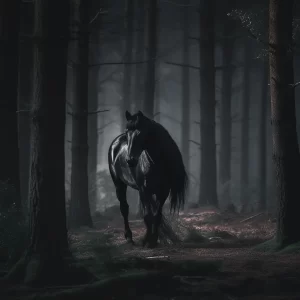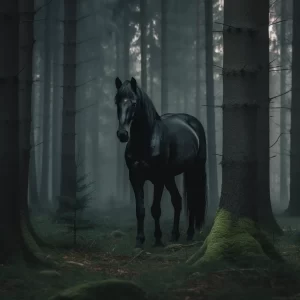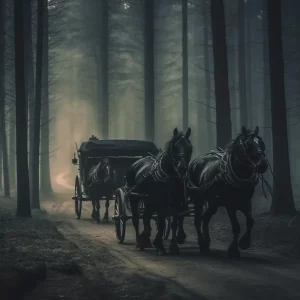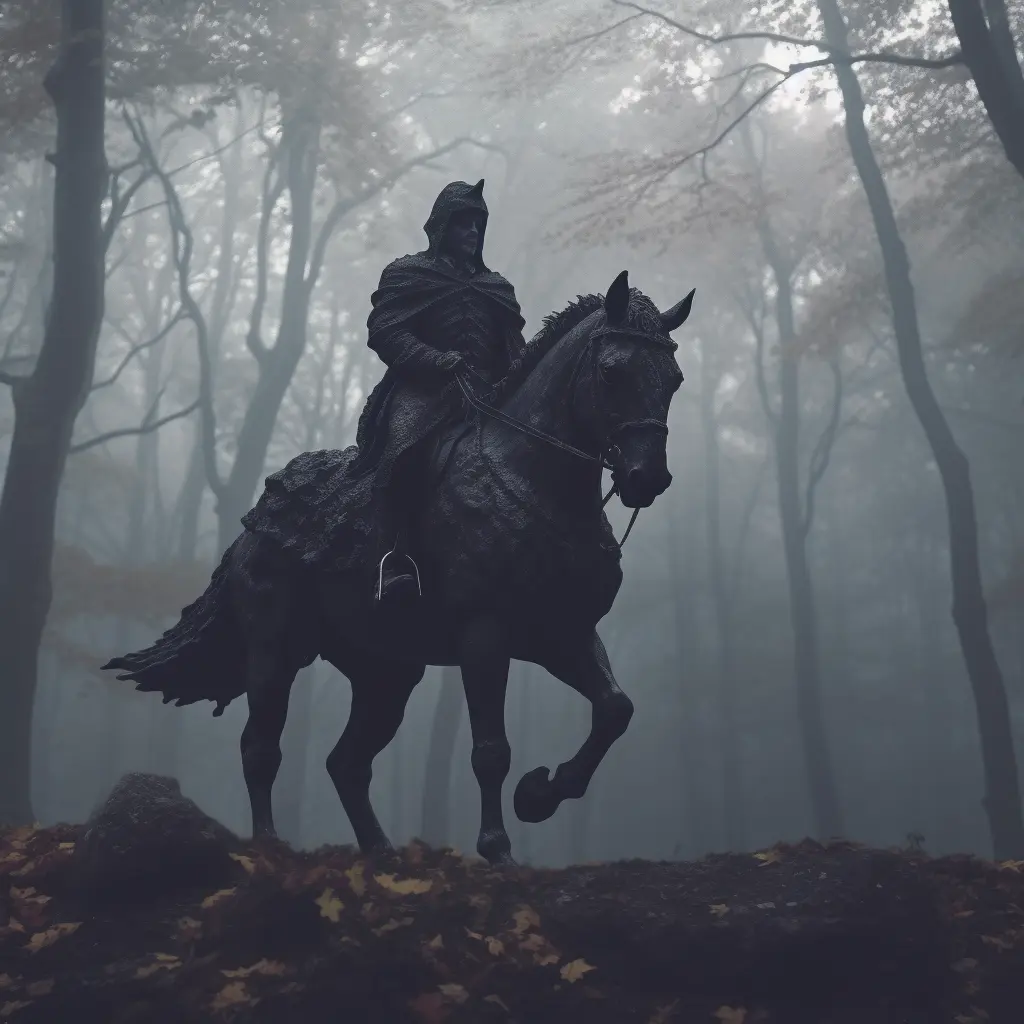The Dullahan is a well-known creature in Irish folklore. Dullahan mythology says that the legendary creature is often depicted as a headless rider, riding on a black horse, while carrying his head either in his hand or under his arm. The Dullahan is also known as Gan Ceann, which means “without a head” in Irish. or as the Irish headless horseman.
The origins of Dullahan Mythology can be traced back to Celtic mythology. It is believed that the Dullahan is the embodiment of the Celtic God Crom Dubh, who demanded blood sacrifice in the past. The Dullahan is often seen as a malevolent harbinger of death, and it is said that when he stops riding, a mortal will die.
The Dullahan is usually seen riding at night on certain festivals and feast days, making him one of the most terrifying creatures in the spirit world.
The history and origins of the Dullahan have been passed down through generations in Irish folklore. Despite being a terrifying creature, the Dullahan has captured the imagination of many, and has been featured in various forms of media, including literature and film. The legend of the Dullahan continues to fascinate and intrigue people to this day.
Dullahan Mythology
The Dullahan is a legendary creature in Irish mythology that is often associated with death and the underworld. As a headless rider on a black horse, he is depicted holding his own head high in his hand or under his arm. In this section, we will explore the Dullahan’s connection with Crom Dubh.
Connection with Crom Dubh
The Dullahan is believed to be the embodiment of the Celtic god Crom Dubh, who was worshipped in Ireland before the arrival of Christianity. Crom Dubh was a fertility god who demanded blood sacrifice, and it is said that the Dullahan also required human sacrifices in his honor. The Dullahan’s association with Crom Dubh makes him a heathen idol, and his existence was likely discouraged by the early Christian church.
Role in Samhain Festival
The Dullahan is closely associated with the Samhain festival, which is celebrated on November 1st and marks the end of the harvest season. During this festival, it was believed that the veil between the living and the dead was at its thinnest, and the Dullahan was said to roam the countryside, searching for souls to claim.
The Dullahan’s presence during the Samhain festival was seen as a harbinger of death, and it was believed that those who encountered him would soon meet their demise. The festival was also a time when feasts were held in honor of the dead, and it is possible that the Dullahan was seen as a reminder of the importance of human sacrifice in appeasing the gods.
Whether he is seen as a malevolent harbinger of death or a powerful heathen idol, there is no doubt that the Dullahan continues to capture the imagination of those who hear his story.

Physical Description and Characteristics
The Headless Horseman
The Dullahan is a type of legendary creature in Irish folklore. He is known as the Headless Horseman because he is depicted as a headless rider on a black horse. He carries his own head held high in his hand or under his arm. The Dullahan is believed to be one of the most terrifying creatures in the spirit world.
The Black Horse
One of Dullahan powers is said to be their black horse which is incredibly fast and powerful. It is believed that the horse can move faster than any other animal and can travel great distances in a short amount of time. The black horse is also said to be immune to any kind of attack.
The Death Coach
The Dullahan is sometimes depicted riding in a black coach, also known as a coach-a-bower or cóiste bodhar. The coach is said to be pulled by six black horses and is driven by a figure with a whip made of human spine. The coach is said to be a harbinger of death and is believed to appear before someone dies.
The Whip Made of Human Spine
The whip made of human spine is said to be one of the most terrifying aspects of the Dullahan. It is believed that the whip can kill anyone who is struck by it. The whip is also said to be used to control the black horses that pull the coach.
Dullahan Powers and Abilities
Supernatural Sight
Dullahan possess supernatural sight that allows them to see things that are invisible to humans. They can see spirits, ghosts, and other supernatural entities that are normally invisible to the naked eye. This ability also allows them to see through illusions and other forms of deception.
Harbinger of Death
Dullahan is known as the Harbinger of Death. They are responsible for announcing the death of a person by calling out their name. They can only speak once on each journey they undertake, and they can only call out the name of the person whose death they herald. Once they call out the name, the person is said to die immediately.
Fear of Gold
Dullahan is said to have a fear of gold. They cannot stand the sight of it and will flee from it as if it were fire. This is why people who travel at night in areas where Dullahan is known to roam will carry a piece of gold with them as protection.
Dullahan is also associated with the Angel of Death and is said to be able to open the gates of death. However, there is no evidence to support this claim, and it is likely a myth. Overall, Dullahan is a powerful and mysterious creature with unique abilities that make it a fascinating subject of folklore and mythology.

Dullahan in Popular Culture
The Dullahan has become a popular figure in popular culture, appearing in various forms of media such as literature, movies, and television shows. This section will explore two notable examples of the Dullahan’s appearance in popular culture: The Legend of Sleepy Hollow and Darby O’Gill and the Little People.
The Legend of Sleepy Hollow
The most famous representation of the Dullahan in literature is Washington Irving’s “The Legend of Sleepy Hollow.” In this story, the antagonist is a headless horseman bearing a striking resemblance to the Dullahan. The story follows Ichabod Crane, a schoolteacher who becomes enamored with a local beauty named Katrina Van Tassel. One night, while returning home from a party at the Van Tassel’s, Ichabod is pursued by the headless horseman. The story ends ambiguously, leaving it up to the reader to decide whether or not the encounter was real or just a figment of Ichabod’s imagination.
Darby O’Gill and the Little People
Another notable appearance of the Dullahan is in the 1959 Disney movie “Darby O’Gill and the Little People.” In the movie, Darby O’Gill is an old Irishman who is visited by the King of the Leprechauns. The two become friends, and Darby learns about the world of the Little People. Later in the movie, Darby is pursued by the Dullahan, who is depicted as a ghostly figure riding a black horse. The Dullahan is portrayed as a harbinger of death, and his appearance is a sign that someone in the town will soon die.
Overall, the Dullahan has become a staple in modern pop culture, appearing in various forms of media. While his appearance may differ from story to story, the Dullahan’s portrayal as a malevolent figure remains consistent.
Regional Variations of Dullahan
Dullahan in County Down
In County Down, the Dullahan is known as Gan Ceann, which means “without a head” in Irish. It is said that this creature rides a black horse and carries its own head under its arm. The Dullahan in County Down is often associated with the Mourne Mountains and is said to appear before the death of a member of a specific family, similar to the Banshee.
Dullahan in Galway
In Galway, the Dullahan is known as the Fear Dorcha, which means “dark man” in Irish. This creature is said to ride a black horse and carry a whip made from a human spine. The Fear Dorcha is often associated with the countryside and is said to appear before the death of a member of a specific family.
Dullahan in Norway
In Norway, the Dullahan is known as the Nattravnen, which means “night raven” in Norwegian. This creature is said to be a harbinger of death and is often associated with the Norse god Odin. The Nattravnen is said to fly through the night sky, carrying a human head in its talons.
In all of these regional variations, the Dullahan is a malevolent creature that is associated with death. While the details of its appearance and behavior may vary, the Dullahan is always a fearsome sight to behold.
Interpretations and Analysis
Dullahan and Christianity
Christianity has had a significant impact on Irish folklore, and the Dullahan is no exception. When Christian missionaries arrived in Ireland, they attempted to convert the pagan population to Christianity. As a result, many pagan beliefs and traditions were either abandoned or adapted to fit the new religion. In the case of the Dullahan, Christian influence can be seen in the interpretation of the creature as a symbol of the devil or evil.
According to Christian tradition, the Dullahan is a fallen angel who was cast out of heaven and condemned to roam the earth. In some versions of the myth, the Dullahan is said to be the ghost of a soldier who was decapitated in battle. The severed head is said to be made of precious metal, such as gold or silver, and is often used as a weapon. In other versions of the myth, the Dullahan is said to be the ghost of a mortal who was decapitated, and his bones are said to be made of iron.
Despite the influence of Christianity on the interpretation of the Dullahan, the creature remains an important figure in Irish folklore. His physical form and the stories surrounding him continue to captivate audiences and inspire new myths and legends. The Dullahan is often associated with other creatures in Irish folklore, such as the banshee and the far dorocha, and his presence is seen as a warning of impending danger.
Whether viewed as a pagan deity or a fallen angel, the Dullahan remains an important figure in Irish folklore and a reminder of the rich cultural heritage of Ireland.

Frequently Asked Questions
What is the origin of the Dullahan?
The Dullahan is a creature from Celtic mythology, specifically Irish folklore. Its origin is believed to be connected to the Celtic God Crom Dubh, who was worshipped by the ancient Irish people.
What are the abilities of the Dullahan?
The Dullahan is known for its ability to travel quickly and silently through the night. It is also said to have supernatural strength and the power to summon storms. Additionally, the Dullahan is known for its ability to see for great distances, even in complete darkness.
Who is Crom Dubh in relation to the Dullahan?
Crom Dubh is believed to be the god of harvest and fertility in Irish mythology. The Dullahan is said to be the embodiment of Crom Dubh and is often referred to as the “Headless Horseman” due to its appearance.
What are some common names for the Dullahan?
The Dullahan is also known as Gan Ceann, which means “without a head” in Irish. It is also sometimes referred to as the “Dark Man” or the “Black Horseman.”
How did the Dullahan come to lose its head?
The origin of the Dullahan’s headless appearance is not entirely clear. Some legends suggest that it was decapitated in battle, while others claim that it was cursed by a powerful witch or sorcerer.
Is the Dullahan typically portrayed as male or female?
The Dullahan is typically portrayed as male in Irish folklore. However, some variations of the legend suggest that there may be female Dullahans as well.
What is the Dullahan?
The Dullahan is a frightening creature that is said to bring death and destruction wherever it goes. Its black horse, death coach, and whip made of human spine are all symbols of its power and its ability to strike fear into the hearts of those who encounter it. While some may dismiss the Dullahan as a mere legend, its presence in Irish folklore continues to captivate and terrify people to this day.
Which creature in irish folklore is depicted as a headless rider?
The Dullahan is the headless rider from Irish folklore
What is the legend of the Dullahan?
The Dullahan is a headless rider from Irish folklore, often seen riding a black horse and carrying their head under one arm. This spectral figure is said to be an omen of death, and when it stops riding, a person dies.
What is a Dullahan in Irish?
In Irish mythology, a Dullahan is a type of unseelie fairy. The term “Dullahan” is derived from the Irish words “dul” (meaning dark or black) and “áhan” (meaning magic or enchantment), suggesting a dark, magical entity.
Are all dullahans female?
No, Dullahans can be both male and female. The myth doesn’t specify a particular gender for the Dullahan, so interpretations can vary.
What are the characteristics of a Dullahan?
A Dullahan is often depicted as a headless rider, carrying its head under its arm. The head is said to have the consistency of moldy cheese and a perpetual grin. The Dullahan rides a black horse and sometimes drives a carriage made of human bones and skin. They are known to whip people with a human spine and are seen as harbingers of death.
What powers do Dullahans have?
Dullahans possess supernatural speed and strength. They are known to call out the name of the person who is about to die, resulting in that person’s immediate death. They are also said to be able to see vast distances despite being headless, and their gaze can cause blindness or even death.
How powerful is a Dullahan?
A Dullahan is considered one of the most powerful and fearsome creatures in Irish folklore. Their presence alone is an omen of impending death, and their supernatural abilities make them formidable entities. They are immune to most mortal weapons and cannot be stopped until they’ve delivered their message of death.
To learn more about Dullahan mythology, check out this video below:


